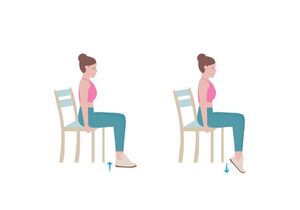Soleus Push Up
Background[edit | edit source]
In 2022, one study discovered a soleus-dominant activity that hinted at potential to increase and sustain local oxidative metabolism at high levels for hours without fatiguing, even for unfit participants[1]. This movement was termed the 'soleus push up' (SPU). The soleus has a high proportion of slow-oxidative fibers, at around 88% of type I slow-twitch fibers, a proportion greater than other fiber typed human muscles[2]. The SPU aims to take advantage of this high proportion of slow twitch fibers, coupled with the fact that slow oxidative muscle is specialised for prolonged activity[3]. The SPU also uses low amounts of glycogen during prolonged contraction, enhancing its ability to engage in prolonged contraction due to the lack of perception of local fatigue[3].
Proposed effectiveness[edit | edit source]
The study found that 130 mins of sustained SPUs burned around 200 calories, while 270 mins burned around 400 calories[3]. It also found that the movement reduced VLDL, or 'bad cholesterol', and can help prevent muscle metabolism during long periods of inactivity, and preserve skeletal muscle[3]. The SPU was also found to help in regulating glucose levels and glucose metabolism[3].
Another study suggested that frequent leg fidgeting, such as the SPU, could be used to prevent impaired central and peripheral cardiovascular function due to sitting and ingesting high-fat meals[4].
Technique[edit | edit source]
In sitting, raise your heel up, and let it drop down back to the floor naturally and repeat this movement.
Application[edit | edit source]
The study used EMG feedback to ascertain that participants were performing the movement correctly. They warned that ability to implement this movement on one's own was whether they could perform the SPU without EMG feedback. Following the study's guidelines, one should accrue 270 minutes of SPUs over the day, without letting more than 4 minutes go by without SPU activity[3]. Raising the range of motion of plantarflexion raised soleus EMG intensity and VO2 more than raising the rate of SPUs. SPUs should thus be done ensuring max range of plantarflexion is achieved[3].
References[edit | edit source]
- ↑ Hamilton MT, Hamilton DG, Zderic TW. A potent physiological method to magnify and sustain soleus oxidative metabolism improves glucose and lipid regulation. iScience. 2022 Aug 5;25(9):104869. doi: 10.1016/j.isci.2022.104869. PMID: 36034224; PMCID: PMC9404652.
- ↑ Johnson JP, Weikiitman D, Ai'I'lcton D. Data on fibre size in thirty-six human muscles. J. neurolog. Sci. 1973;19:307-18.
- ↑ 3.0 3.1 3.2 3.3 3.4 3.5 3.6 Kuo IY, Ehrlich BE. Signaling in muscle contraction. Cold Spring Harb Perspect Biol. 2015 Feb 2;7(2):a006023. doi: 10.1101/cshperspect.a006023. PMID: 25646377; PMCID: PMC4315934.
- ↑ Fryer S, Paterson C, Turner L, Moinuddin A, Faulkner J, Stoner L, et al. Localized activity attenuates the combined impact of a high fat meal and prolonged sitting on arterial stiffness: A randomized, controlled cross-over trial. Frontiers in physiology. 2023;14:1107456–1107456.







